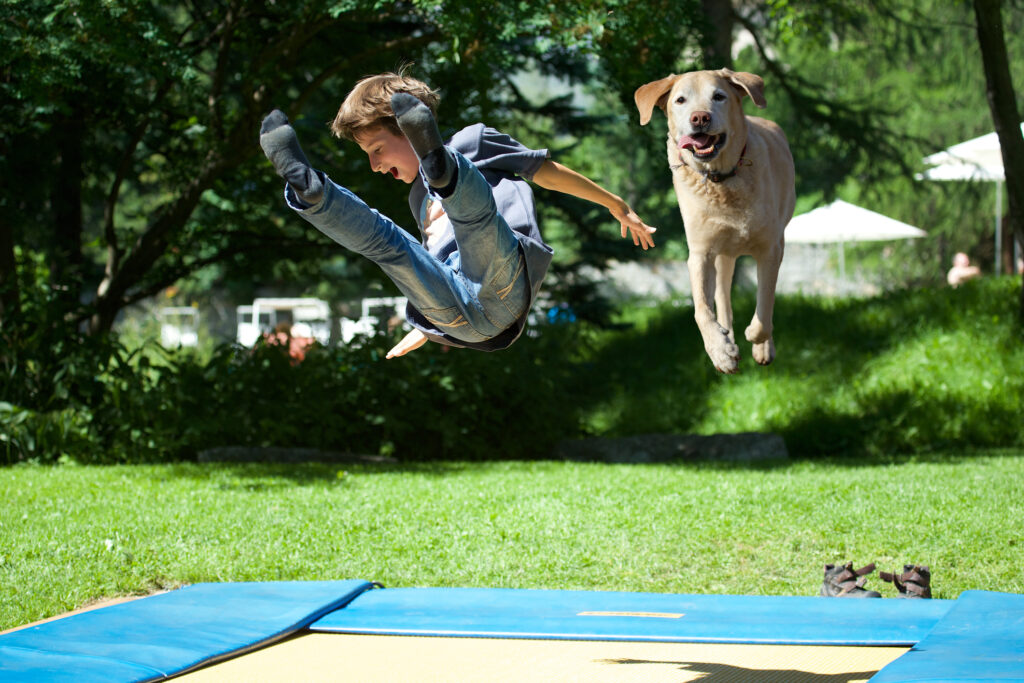Trampolines aren’t just for kids anymore—they’ve become a playground for our furry friends too! If you’re a dog lover, pet owner, or a family with pets, you might have noticed an increasing trend: dogs on trampolines. These bouncy adventures not only bring joy to our four-legged companions but also create countless moments of laughter and entertainment for us. In this blog post, we’ll explore why dogs love trampolines, the benefits of this playful activity, and some safety tips to ensure your pups bounce safely.

Why Do Dogs Love Trampolines?
Just like their human counterparts, dogs are naturally curious and energetic. The unique feel of a trampoline provides a new sensory experience that many dogs find intriguing. Here are a few reasons why dogs might be drawn to trampolines:
- Bounce and Fun: The unpredictable bounce adds an element of surprise that many dogs find exciting. It mimics the playfulness they experience when running or jumping through grass.
- Energy Release: Trampolines offer a great way for high-energy dogs to burn off some of that excess energy. The jumping motion is both physically and mentally stimulating.
- Interactive Play: Dogs love to interact with their owners, and playing on a trampoline together can strengthen your bond. Whether you’re bouncing alongside them or tossing a ball for them to chase, it’s a shared experience that both you and your dog will enjoy.
Benefits of Trampoline Play for Dogs
It’s not just about fun and games—trampoline play offers several benefits for your canine companions:
1. Physical Exercise
Jumping on a trampoline is a fantastic workout for dogs. It helps build muscle strength, improves coordination, and enhances cardiovascular health. For dogs that need to shed a few pounds, trampoline play can be an enjoyable way to stay active.
2. Mental Stimulation
The unique experience of bouncing on a trampoline can provide mental stimulation for dogs, keeping their minds sharp and engaged. This is especially important for intelligent breeds that require constant mental challenges.
3. Stress Relief
Just as physical exercise releases endorphins in humans, the same applies to dogs. The playful activity on a trampoline can help reduce stress and anxiety, leading to a happier and more relaxed pup.
Safety Tips for Trampoline Play
While trampolines can be a source of great fun, it’s important to ensure that your dog’s playtime is safe. Here are some tips to keep in mind:
Supervision
Always supervise your dog while they’re on the trampoline. This ensures that you can prevent any risky behavior and step in if something goes wrong.
Size Matters
Make sure the trampoline is appropriate for your dog’s size. Small dogs might need lower bounces to prevent joint strain, while larger dogs require a trampoline that can handle their weight.
Safe Entry and Exit
Ensure that your dog can safely get on and off the trampoline. A ramp or step can help smaller or older dogs access the trampoline without jumping and risking injury.
Inspect the Trampoline
Regularly check the trampoline for any wear and tear. Ensure that the mat is intact, springs are covered, and there are no sharp edges that could harm your dog.
Controlled Play
Encourage controlled play and discourage excessive bouncing or roughhousing. This will help prevent injuries and ensure that the trampoline remains a fun and safe environment for your dog.
Conclusion
Trampoline play can be a delightful and beneficial activity for your dog. With the right precautions and supervision, it can provide physical exercise, mental stimulation, and a whole lot of fun. Whether your pup is doing flips, chasing balls, or simply enjoying the bounce, watching them on a trampoline is guaranteed to bring a smile to your face.
So next time you’re setting up the trampoline in your backyard, consider inviting your dog for a bounce. After all, why should humans have all the fun? Happy bouncing!
Have you tried letting your dog on the trampoline? Share your experiences and photos in the comments below!
